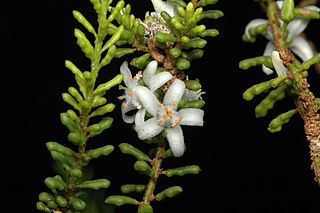
Philotheca verrucosa, commonly known as fairy wax-flower or Bendigo wax-flower, is a species of flowering plant in the family Rutaceae and is endemic to south-eastern Australia. It is a small shrub with prominently glandular-warty branchlets, heart-shaped or egg-shaped leaves with the narrower end towards the base, and white flowers usually arranged singly in leaf axils.

Philotheca salsolifolia is a species of flowering plant in the family Rutaceae and is endemic to New South Wales and the Australian Capital Territory. It is a shrub with crowded, more or less cylindrcal leaves and pink to mauve flowers with a dark central stripe and arranged singly or in twos or threes on the ends of branchlets.
Philotheca pungens, commonly known as prickly waxflower, is a species of flowering plant in the family Rutaceae and is endemic to south-eastern Australia. It is an undershrub with linear to narrow oblong or needle-like leaves and white flowers usually arranged singly in leaf axils.
Philotheca apiculata is a species of flowering plant in the family Rutaceae and is endemic to the south-west of Western Australia. It is a small shrub with narrow club-shaped leaves and small clusters of white to pink flowers on the ends of branchlets.

Philotheca coccinea is a species of flowering plant in the family Rutaceae and is endemic to Western Australia. It is a shrub with club-shaped leaves that are warty on the lower surface, and red to pink flowers arranged singly in leaf axils.

Philotheca conduplicata is a species of flowering plant in the family Rutaceae and is endemic to eastern Australia. It is a shrub with elliptical leaves clustered near the ends of the branchlets and white flowers arranged singly or in two or threes on the ends of the branchlets.
Philotheca cuticularis is a species of flowering plant in the family Rutaceae and is endemic to Queensland. It is a rounded shrub with small, crowded leaves and small white flowers arranged singly on the ends of branchlets.
Philotheca cymbiformis is a species of flowering plant in the family Rutaceae and is endemic to the south-west of Western Australia. It is a low, spreading small shrub with fleshy, narrow elliptic leaves and single white and reddish brown flowers on the ends of branchlets.

Philotheca epilosa is a species of flowering plant in the family Rutaceae and is endemic to eastern Australia. It is a shrub with egg-shaped to lance-shaped leaves with the narrower end toward the base and crowded near the ends of the glandular-warty branchlets, and white flowers usually arranged singly on the ends of the branchlets.
Philotheca ericifolia is a species of flowering plant in the family Rutaceae and is endemic to New South Wales. It is a much-branched shrub with glandular-warty branchlets, needle-shaped leaves and white to pink flowers arranged singly or in groups of up to six on the ends of the branchlets.
Philotheca falcata, commonly known as the sickle-leaved waxflower, is a species of flowering plant in the family Rutaceae and is endemic to a small area in the south-west of Western Australia. It is a small, densely-branched shrub with narrow club-shaped leaves and single flowers on the ends of branchlets.
Philotheca fitzgeraldii is a species of flowering plant in the family Rutaceae and is endemic to the south of Western Australia. It is an erect, compact or spreading shrub with cylindrical, glandular-warty leaves and white flowers arranged singly in leaf axils and on the ends of branchlets.

Philotheca gardneri is a species of flowering plant in the family Rutaceae and is endemic to the south-west of Western Australia. It is a shrub with crowded, narrow club-shaped or more or less spherical leaves and white flowers with a prominent pink midrib, usually borne singly on the ends of branchlets.
Philotheca glabra is a species of flowering plant in the family Rutaceae and is endemic to the inland south-west of Western Australia. It is a small shrub with elliptical to club-shaped leaves and white flowers tinged with pink and arranged singly or in twos or three on the ends of branchlets.
Philotheca kalbarriensis is a species of flowering plant in the family Rutaceae and is endemic to Western Australia. It is a shrub with reddish brown branchlets and crowded, narrow spindle-shaped leaves and single white flowers arranged in leaf axils.

Philotheca pachyphylla is a species of flowering plant in the family Rutaceae and is endemic to Western Australia. It is a small shrub with fleshy, oblong, prominently glandular-warty leaves and white flowers arranged singly in leaf axils.

Philotheca pinoides is a species of flowering plant in the family Rutaceae and is endemic to the south-west of Western Australia. It is a small, erect undershrub with needle-shaped, glandular-warty leaves and pale pink or red flowers arranged singly or in groups of up to three in the axil of leaves at the end of branchlets.
Philotheca rhomboidea is a species of flowering plant in the family Rutaceae and is endemic to the south-west of Western Australia. It is a small undershrub with thick, broadly elliptic to round leaves and white to pale pink flowers arranged singly or in twos or threes at the end of branchlets.

Philotheca sericea is a species of flowering plant in the family Rutaceae and is endemic to the south-west of Western Australia. It is an undershrub with small oval to elliptical leaves and white to pink flowers usually arranged singly at the end of branchlets.

Philotheca tomentella is a species of flowering plant in the family Rutaceae and is endemic to the south-west of Western Australia. It is an undershrub with small club-shaped to cylindrical leaves and white flowers with a pale red central stripe, arranged singly or in groups of up to four on the ends of branchlets.










